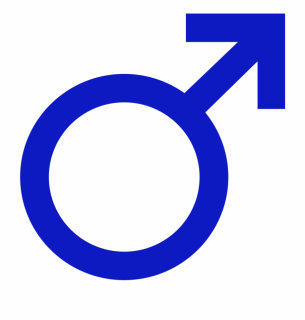Male

Male

A male (♂) organism is the physiological sex that produces sperm. Each spermatozoon can fuse with a larger female gamete, or ovum, in the process of fertilization. A male cannot reproduce sexually without access to at least one ovum from a female, but some organisms can reproduce both sexually and asexually. Most male mammals, including male humans, have a Y chromosome, which codes for the production of larger amounts of testosterone to develop male reproductive organs. Not all species share a common sex-determination system. In most animals, including humans, sex is determined genetically, but in some species it can be determined due to social, environmental, or other factors. For example, Cymothoa exigua changes sex depending on the number of females present in the vicinity.[1]
Overview
The existence of two sexes seems to have been selected independently across different evolutionary lineages (see convergent evolution). The repeated pattern is sexual reproduction in isogamous species with two or more mating types with gametes of identical form and behavior (but different at the molecular level) to anisogamous species with gametes of male and female types to oogamous species in which the female gamete is very much larger than the male and has no ability to move. There is a good argument that this pattern was driven by the physical constraints on the mechanisms by which two gametes get together as required for sexual reproduction.[2]
Accordingly, sex is defined operationally across species by the type of gametes produced (i.e.: spermatozoa vs. ova) and differences between males and females in one lineage are not always predictive of differences in another.
Male/female dimorphism between organisms or reproductive organs of different sexes is not limited to animals; male gametes are produced by chytrids, diatoms and land plants, among others. In land plants, female and male designate not only the female and male gamete-producing organisms and structures but also the structures of the sporophytes that give rise to male and female plants.
Symbol
A common symbol used to represent the male sex is the Mars symbol ♂, a circle with an arrow pointing northeast. The Unicode symbol is:
- (HTML·: Alt+11)
The symbol is identical to the planetary symbol of Mars. It was first used to denote sex by Carl Linnaeus in 1751. The symbol is often called a stylized representation of the Roman god Mars' shield and spear. According to Stearn, however, all the historical evidence favours that it is derived from θρ, the contraction of the Greek name for the planet Mars, which is Thouros.[3]
Sex determination
The sex of a particular organism may be determined by a number of factors.
These may be genetic or environmental, or may naturally change during the course of an organism's life.
Although most species with male and female sexes have individuals that are either male or female, hermaphroditic animals, such as worms, have both male and female reproductive organs.
Genetic determination
Most mammals, including humans, are genetically determined as such by the XY sex-determination system where males have an XY (as opposed to XX) sex chromosome. It is also possible in a variety of species, including humans, to be XXY or have other intersex/hermaphroditic qualities, though one would still be considered genotypically (if not necessarily phenotypically) male so long as one has a Y-chromosome. During reproduction, a male can give either an X sperm or a Y sperm, while a female can only give an X egg. A Y sperm and an X egg produce a male, while an X sperm and an X egg produce a female.
The part of the Y-chromosome which is responsible for maleness is the sex-determining region of the Y-chromosome, the SRY. The SRY activates Sox9, which forms feedforward loops with FGF9 and PGD2 in the gonads, allowing the levels of these genes to stay high enough in order to cause male development;[4] for example, Fgf9 is responsible for development of the spermatic cords and the multiplication of Sertoli cells, both of which are crucial to male sexual development.[5]
The ZW sex-determination system, where males have a ZZ (as opposed to ZW) sex chromosome may be found in birds and some insects (mostly butterflies and moths) and other organisms. Members of the insect order Hymenoptera, such as ants and bees, are often determined by haplodiploidy, where most males are haploid and females and some sterile males are diploid.
Environmental determination
In some species of reptiles, such as alligators, sex is determined by the temperature at which the egg is incubated. Other species, such as some snails, practice sex change: adults start out male, then become female. In tropical clown fish, the dominant individual in a group becomes female while the other ones are male.
In some arthropods, sex is determined by infection. Bacteria of the genus Wolbachia alter their sexuality; some species consist entirely of ZZ individuals, with sex determined by the presence of Wolbachia.
Secondary sex characteristics
In those species with two sexes, males may differ from females in ways other than the production of spermatozoa.
In many insects and fish, the male is smaller than the female.
In seed plants, which exhibit alternation of generations, the female and male parts are both included within the sporophyte sex organ of a single organism. In mammals, including humans, males are typically larger than females. In birds, the male often exhibits a colorful plumage that attracts females.
See also
Boy
Female
Gender
Male plant
Male pregnancy
Man
Masculinity
Gentleman